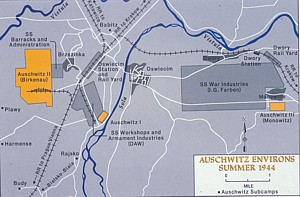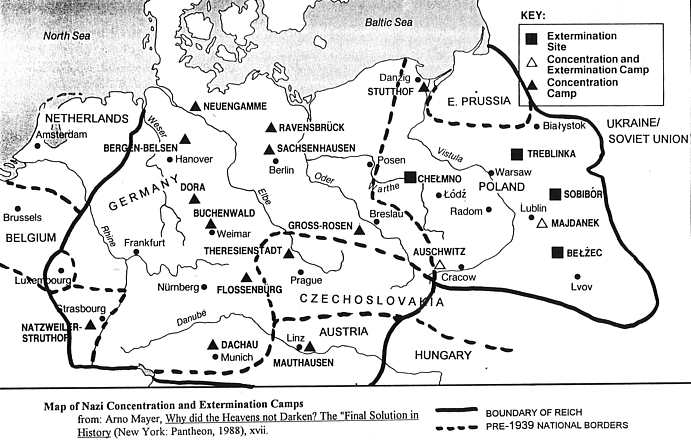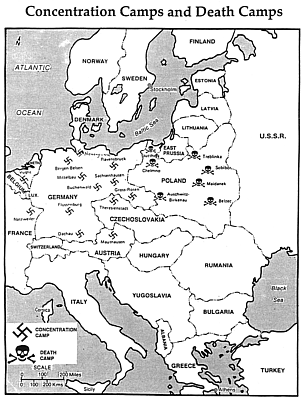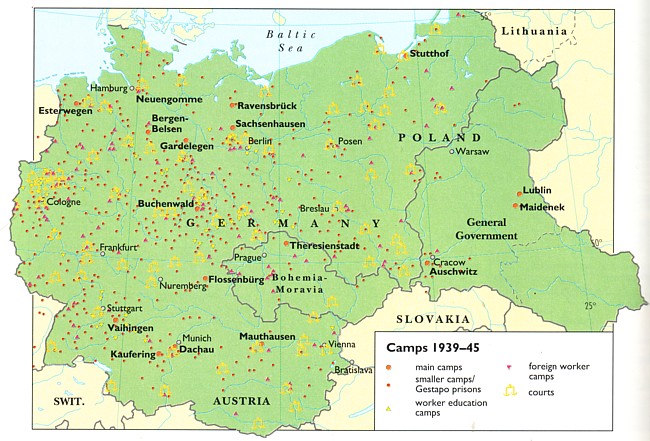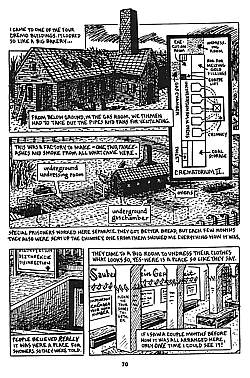| 1.
The Idea of Concentration Camps (back to top)
Method of fighting grassroots resistance�(popular insurgency
supported by civilians)
- Historically, "concentration camps" were NOT invented by
the Nazis, but used in what we now call colonial counterinsurgency wars.
- "Spanish-American" (US-Cuban) War, 1898: Spanish policy
of "reconcentration" of civilians to pacify the countryside
- Boer War (1899-1902): British repressed Dutch settler (Boer) resistance
in South Africa
- Hitler knew about the South African precedent, and
spoke openly about it. Using concentration camps was part of his plan
for Germany since the early 1920s:
- Hitler in a Sept. 20, 1920 speech 'Power or
Justice' ("Macht oder Recht") to a gathering of about
2,000 NSDAP followers (20-25% women) in the Munich Kindl-Keller,
8-11pm (Jäckel/Kuhn, 229-233), as reported by police and Reichswehr
intelligence, and in the Munich Newest News on Sept. 22:
"In South
Africa, England deported 76,000 Boer women and children to concentration
camps, thus forcing the men to return to their homes."
- On March 13, 1921 Hitler published an article
in the Völkischer Beobachter, titled 'Rathenau and
Sancho Panza,' in which he demanded a revision of the Versailles
Treaty (Jäckel/Kuhn, 341-348). He called for rebellion, sabotage
and strikes in all occupied areas. Anyone who betrayed the fatherland
to the occupiers should be hanged. The rich and lazy, he continued,
should be dealt with first by
"locking
them up in national work service. ... The Jewish undermining of
our people should be prevented by, if necessary, keeping their provacateurs
secure in concentration camps. In short, our people should be cleansed
of all poison from above and below."
[Verräter
an der nationalen Volkssache sind für ein für allemal
aufzuhängen. Verräter aber sei uns künftig nicht
nur der, der irgend eine Kannone oder Gewehr denunziert, sondern
auch der, der in des Volkes tiefster Not in seinen Volksgtenossen
immer noch nicht mehr sieht, denn ein Objekt zu seiner Ausbeutung.
Man räume unsere feinen Luxusstätten aus und sperre diese
ganze faulenzende Drohnen-Gesellschaft als erste in den nationalen
Arbeitsdienst. Den Kommissionen stelle man die Pässe zu. Man
verhindere die jüdische Unterhöhlung unseres Volkes, wenn
notwendig durch die Sicherung iherer Erreger in Konzeentrationslagern.
Kurz man reinige unser Volk von all dem Gifte oben und unten. Denn
nur mit einem reinen Volk wird man den kommenden schweren Zeiten
entgegentreten können und nicht mit einem verlumpten. Denn
endlich muss die Parole dieser internationlen Börsen- und Finanzbanditengesellschaft
nicht mehr lauten: Unterhandeln um jeden Preis, sondern Widerstand
bis zum Äussersten!!"
- On Sept. 18, 1922 Hitler spoke to a gathering
of the NSDAP in the Circus Krone in Munich, which was attended by
about 6,000 people. He concluded his speech with a list of 9 demands.
These were printed in theVölkischer Beobachter on
Sept. 20, and reprinted in Ernst Boepple (ed.), Adolf Hitlers
Reden (Munich, 1934), 3rd ed. pp. 36ff. (Jäckel/Kuhn 690-693).
First he demanded revenge on the "November crimiinals of 1918,"
2. ending national shame by hanging traitors, 3. cleansing the state
of rabble, 4. draconian punishment of people charging high interest,
5. education about the peace treaty, 6. no more lying about the
bad state of affairs, 7. the assets of "those who don't belong
here" [in the 193 publication: "those who aren't of our
blood"] should be the basis for a new currency, 8. immediate
extradition of all Jews who immigrated after 1914 or who got rich
on the stock market, and 9:
'The desperate
shortage of housing must be relieved by vigorous means, by giving
apartments to those who deserve them. Eisner said in 1918 that we
had no right to demand the return of our prisoners. A people that
thinks like that (Eisner only said openly what all Jews were thinking),
has to feel how it feels to live in concentration camps! Extremes
must be met by extreme measures. We must counter the materialistic
pollution, the Jewish plague, by holding up our flaming ideal. And
when the others speak about the world and humanity, we say, "The
fatherland only!"'
- Eisner was the socialist newspaper editor who headed the revolutionary
government of Bavaria from Nov. 7, 1918 until he was assassinated
on Feb. 21, 1919. Note how Hitler shrinks morality to 'Germans
only--forget about the rest of society and the world.'
Pre-1933 Nazi Plans
- Nov. 1923 Nazi takeover plan: "The regional
administrators will immediately … take measures to purge and unburden
the cities and resort towns, in particular they will remove all security
risks and useless eaters. These people are, if necessary, to be put
into collection camps, and if possible to be put to work on communal
projects. Whoever resists or attempts to resist the transfer will be
punished by death."
- August 1932 Völkischer Beobachter
(National Observer):�When we are in power, the new National
Socialist government will "immediately arrest and condemn all Communist
and Social Democratic functionaries … [and] quarter all suspects and
intellectual instigators in concentration camps."
- These quotations can be found in the published version
of Johannes Tuchel's dissertation: Konzentrationslager: Organisationsgeschichte
und Funktion der "Inspektion der Konzentrationslager," 1934-1938
(Boppard: Boldt, 1991), pp. 36ff; I quote and translate them in my book
Legacies of Dachau (2001), p. 19.
Primary function: "Pacification" of populace.
Camps are still used for that purpose today, as the cartoon below shows.
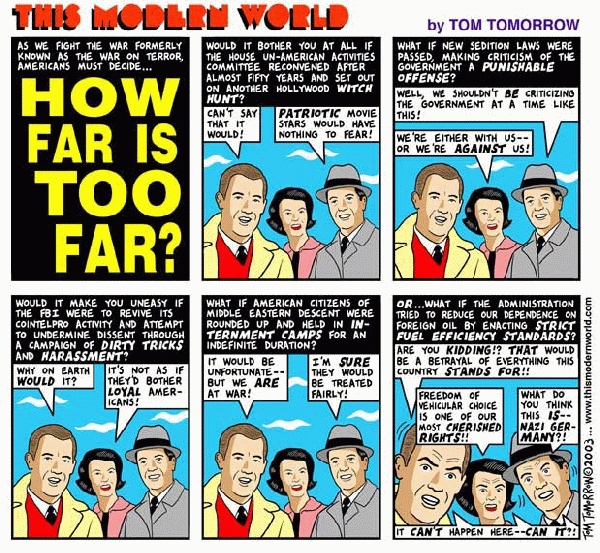
|
